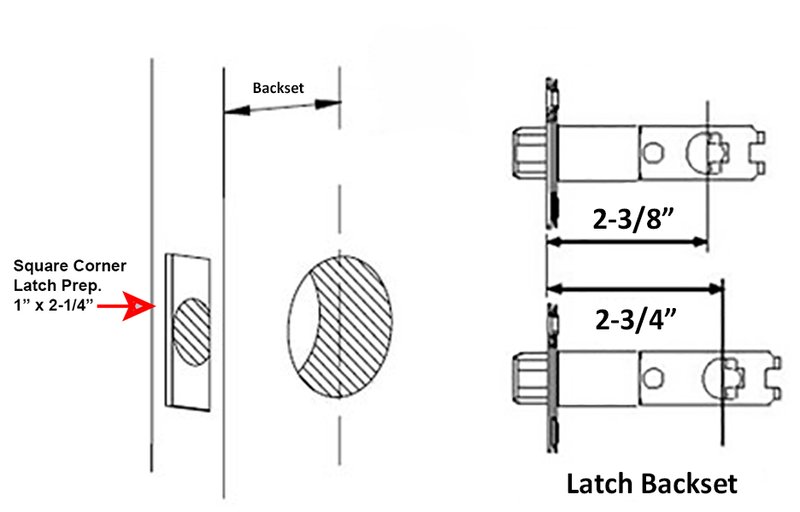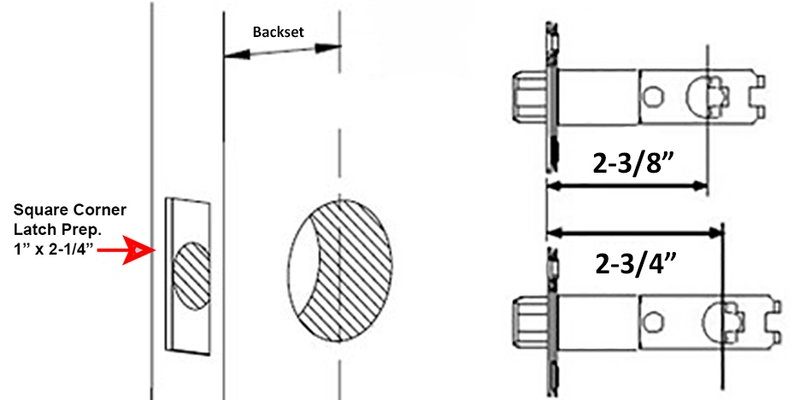
Backset is the distance from the edge of the door to the center of the hole where the doorknob, lever, or latch sits. It’s a term you’ll hear often in the world of door hardware. Most interior doors come with backsets of either 2 3/8 inches or 2 3/4 inches, but you can’t assume yours will be the same. Let’s walk through how to measure backset accurately so you can replace your door hardware without a hitch.
Why Measuring Backset Matters
Understanding backset is more than just math; it’s about ensuring your door functions correctly. A mismatched backset can lead to a host of issues ranging from aesthetics to functionality. Picture this: you install a stunning new handle only to find it’s positioned so awkwardly that it’s hard to grip. Not only is it frustrating, but it can also affect the door’s operation.
When replacing door hardware, measuring backset correctly ensures that the new hardware lines up perfectly with existing holes. This means less hassle, fewer repairs, and a smoother finish. You’ll not only save time but also avoid the headache of returning items that won’t fit.
How to Measure Backset
Measuring the backset is straightforward, and you don’t need fancy tools. Here’s a simple method to get it right:
1. Gather Your Tools: All you need is a tape measure and a pencil or a piece of tape.
2. Position the Door: Open the door fully to ensure you have space to measure.
3. Measure from the Edge: Take your tape measure and place one end at the edge of the door. Extend it to the center of the hole where the doorknob or latch is positioned.
This distance is your backset. Don’t forget to double-check your measurements; it’s better to be safe than sorry!
Common Backset Sizes
Most interior doors in homes use standard backsets. The two most common sizes are:
- 2 3/8 inches: This is the most common size for standard interior doors.
- 2 3/4 inches: Found more often in doors that require added security, like exterior doors.
Knowing these sizes can help you select the correct hardware easily. But if you’ve got an older door or a custom design, you might find more variations. That’s why measuring is essential.
What to Do If Your Backset is Non-Standard
Sometimes, you might discover that your door has a non-standard backset—this can be tricky but not impossible to deal with. Here’s what you can do:
1. Look for Adjustable Hardware: Many modern door handles come with adjustable backsets. This means you can customize the fit without having to drill new holes.
2. Consider a Different Style: If your door is an odd size, you might need to look for less common hardware styles. Don’t shy away from reaching out to specialty hardware stores—they can often provide options where big box stores might not.
If you can’t find a direct match, some hardware brands may offer custom solutions. It’s worth asking.
Measuring Backset: A Step-by-Step Guide
Here’s a more detailed step-by-step guide to measuring the backset:
Step 1: Remove Existing Hardware
Start by unscrewing and taking off any existing hardware, like the doorknob or lever. This will give you clear access to the holes for measuring.
Step 2: Clean the Area
While your hardware is off, it’s a good idea to clean the area. Dust and debris can affect your measurements.
Step 3: Measure Twice
Use a tape measure and take your measurement again—it’s always best to measure twice to ensure accuracy. If you’re unsure, ask someone to double-check your numbers, too.
Step 4: Record Your Measurements
Write down your findings. You might want to also note the diameter of the hole for future reference, as many handles have specific hole size requirements.
Examples of How Backset Affects Installation
Let’s say you’ve measured your backset as 2 3/8 inches, but you purchase hardware designed for a 2 3/4-inch backset. This difference may lead to the handle being set back too far into the door, making it difficult to use comfortably.
Additionally, improper alignment can cause the latch to misalign with the strike plate, leading to that annoying scenario where the door doesn’t close properly. You might be scratching your head wondering why you can’t just push the door shut. It all circles back to that one measurement!
Final Tips for Successful Door Hardware Replacement
To wrap things up, here are some key takeaways for a successful door hardware replacement:
- Take your time measuring: A rushed measurement can lead to costly mistakes.
- Know your door type: Hollow core doors may have unique hardware requirements compared to solid wood doors.
- Communicate with retailers: When in doubt, don’t hesitate to ask for help from knowledgeable staff at hardware stores.
Remember, this process doesn’t have to be stressful. With the right measurements, you’ll ensure a smooth installation and a functional door that looks great.
Replacing door hardware can seem daunting, but it’s all about the details. By understanding how to measure backset accurately, you can approach this project with confidence. Happy DIY-ing!
